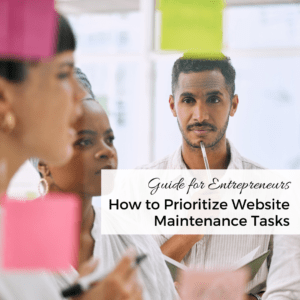- +1 512-591-8295
- [email protected]
- Mon - Fri: 9:00 - 16:00

As a business owner, managing your website can be overwhelming with countless tasks demanding your attention. From fixing urgent issues to enhancing user experience, knowing which tasks to prioritize is crucial. This guide will help you understand how to classify and tackle website tasks effectively, ensuring your site runs smoothly and your business thrives.
While I never recommend that you do these tasks yourself – you need to remain focused on your own Zone of Genius, which likely does not include websites and marketing – you still need a solid understanding of how critical some of these tasks are compared to others, so that you can mentally prioritize and understand what must be fixed today, and what may be able to leave for later. This helps you with budgeting your time and money. Every successful entrepreneur already knows how important it is to prioritize, but it can be hard to know how to do so with tasks outside of your zone.
Website maintenance and updates are essential for keeping your site functional, secure, and appealing to visitors. However, not all tasks have the same level of urgency. By categorizing tasks into different levels of priority, you can focus on what matters most, avoiding unnecessary stress and optimizing your time and resources.
This is the prioritization matrix that I use with my own client website projects, based upon over 25 years of website design:
Definition: These tasks are emergency issues that make the website inaccessible or severely impair its functionality, preventing users from making purchases or accessing essential content.
Definition: These tasks directly impact the site’s security, performance, or important functionality. They need to be addressed promptly to prevent potential issues.
Definition: These tasks are important but do not critically affect the site’s core functionality or immediate user experience. They are beneficial but can wait if higher priority issues arise.
Definition: These tasks are enhancements or minor issues that do not impact the core functionality of the website or user experience.
By understanding the urgency of different website tasks, you can make informed decisions and ensure that critical issues are addressed promptly while also planning for long-term improvements. This approach not only keeps your website in top shape but also enhances the overall user experience, leading to better customer satisfaction and potentially higher conversions.
Whether you’re handling your website tasks yourself or working with a professional, having a clear priority system in place can make a significant difference. It allows you to allocate your time and budget more effectively, ensuring that the most important tasks are never overlooked. As a result, your website remains a powerful tool for your business, driving traffic, engagement, and sales.
For more information on website design and maintenance services, feel free to contact us or explore our website design services.
By following these guidelines, you can keep your website running smoothly and efficiently, addressing the most critical issues promptly while managing expectations and workload effectively.
I get it, if you’re not a website guru, it can be a major headache to keep everything running smoothly.
That’s why we offer a selection of WordPress Website Maintenance plans to fit your needs.
Get solid marketing strategies, designed for entrepreneurs on the track to 7-figures and beyond, right in your inbox.

This website uses cookies to ensure you get the best experience on our website. By continuing to use the website, you agree to our use of cookies. We do not share or sell your information. More info
